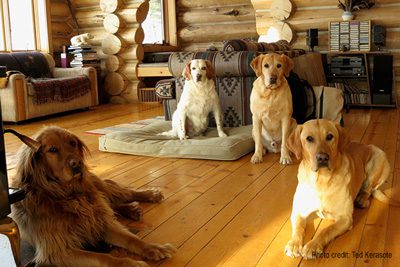
Nov 23, 2022 Thanksgiving, Family & Pets: A time to reflect on family ties
Thanksgiving is perhaps the most important family holiday in the United States. As we head into the coming week and the gathering of family members, it seems appropriate to reflect on our families and who is included at this critical time. In the Rowan household, pets have been consistently recognized as full family members. When the children were growing up, our pets numbered two feline siblings – Cassandra and Mistofeles (yes – named after two of the cats in T.S. Eliot’s Old Possum’s Book of Practical Cats) – but they both left us after sixteen years. Currently, the extended Rowan family is enriched by the presence of two rescue dogs and three rescue cats.
In this analysis, we will focus on our canine members and hope that our ailurophilic readers and avian pet caregivers will forgive the slight. Rowan’s canine family members included Charles (a rescue from a Maryland shelter who is now deceased) and currently comprise Abby and Bonnie, two recent rescues who are enriching the lives of Andrew and Kathleen (Abby) and Andrea, Julian, and Max (Bonnie). Both dogs will be at the family gathering on Thanksgiving Thursday, but Jennifer and Tom’s three rescue cats will remain at home. While the cats will have special treats at their home, both dogs will be hoping to share some of the available food!
The canine presence in and importance to human families is something of a mystery. It is generally agreed that dogs descended from wolves, but how that happened is still debated. For much of the time dogs have shared our human lives, their presence was taken for granted. But, in the last few decades, centers of canine studies have sprung up in universities around the world (for instance, at universities in Southampton, Bristol, Duke, Tucson, Vienna, and Budapest). These centers/institutes are now providing insights into how dogs have become such favored members of human families.

Ted Kerasote’s dogs, from left to right, Burley, Goo, AJ and Pukka
There are many books on dogs (Amazon lists 70,000, including novels!), and dogs have a 2 to 1 margin over cats in the number of books in print, while cats dominate the online space, also by a 2 to 1 margin. Nevertheless, I will mention only three books on dogs that seem particularly appropriate for this article (with apologies to the authors of many other excellent books on the subject). The books are Mark Derr’s Dog’s Best Friend (2004, University of Chicago Press), John Homans’ What’s a Dog For? (Penguin, 2013) and Ted Kerasote’s Pukka’s Promise (Houghton Mifflin Harcourt, 2014).
The choice of any three books (out of 70,000) on which to comment will inevitably be idiosyncratic. However, the three books selected are by a self-taught expert on dogs and their origins (Derr), a former NY Times magazine editor (Homans), and an author who lives what he writes about (Kerasote). Derr is an expert on dogs, and his book, Dog’s Best Friend, exudes that expertise through every page but is also peppered with the inevitable whimsical anecdotes that a life with dogs will elicit. For example, he talks of one dog (Max) who insisted on picking up and carrying a ten-foot branch for a mile during a walk.
Homans’ book is focused on the question plaguing most dog owners – namely, what is my dog thinking? The primary source for many of the book’s findings is the 2010 Second Canine Science Forum organized by the canine science center at the University of Vienna. By contrast, Kerasote sets out to find a replacement for his beloved Merle. He is particularly concerned about finding a dog who will live a long and healthy life. In his search, he talks to breeders to find out why dogs do not live longer (a universal lament for most dog owners) and to other specialists on how best to feed a dog and protect it from disease.
All three books provide insights and findings that fascinate some dog owners and offer answers to some of the questions raised by many other dog owners. In conclusion, here are a few words from Mark Derr from his book’s prologue.
“[Dogs] provide for me a certain calm, a connection to the broader world we call nature, a world beyond human control. They remind me that the human way of viewing reality is circumscribed by our senses, our bipedalism, our brains. They daily teach me that kindness, consistency, patience, and understanding succeed much better than intimidation.”
Happy Thanksgiving with your family – and don’t forget to feed the dog (or cat, or bird)!


